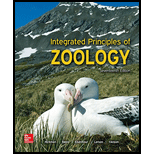
Outline Berthold’s first endocrine experiment. What was the hypothesis?
To outline: The first endocrine experiment conducted by Berthold’s and to explain its hypothesis.
Introduction: Endocrinology is a branch of biology and medicine that deals with the endocrine system of a body. The endocrine system has glands that secrete chemical messengers known as hormones. The hormones control several organs and organ systems of the body. Examples of hormones include insulin, growth hormone, and thyroid hormone.
Explanation of Solution
The first endocrinology experiment was conducted by Professor Arnold Adolph Berthold in the year 1849.
The outline of the endocrine experiment is as follows:
Hypothesis: To understand if the blood-borne chemical signal produced by the testes influences both the physical and behavioral characteristics in an adult chicken.
Method: Berthold chose castrated male chickens for the experiment. It was divided into three groups:
Group 1 - Castrated male chickens without any treatments.
Group 2 - Castrated male chickens with their own testes reimplanted.
Group 3 - Castrated male chickens with testes implanted from different chicken. Berthold killed and dissected the chickens after they were matured. The testes from the chickens were also examined.
Results: The observations of Berthold from the experiment were, in Group 1, the chickens grew and developed into capons, with no interest in hens. These chicks lacked aggressive behavior and rooster feathers. Group 2 and 3 chickens behaved and looked the same. Both groups developed male aggressive behavior and rooster plumage. The transplanted testes examined from Group 3 chickens showed that they developed their own blood supply and produced normal functions.
Conclusion: The development of male characteristics in a chicken both physical and behavioral was through a chemical signal carried in the blood and that no nerve supply was essential.
Want to see more full solutions like this?
Chapter 34 Solutions
LooseLeaf for Integrated Principles of Zoology
- What is the structure and function of Eukaryotic cells, including their organelles? How are Eukaryotic cells different than Prokaryotic cells, in terms of evolution which form of the cell might have came first? How do Eukaryotic cells become malignant (cancerous)?arrow_forwardWhat are the roles of DNA and proteins inside of the cell? What are the building blocks or molecular components of the DNA and proteins? How are proteins produced within the cell? What connection is there between DNA, proteins, and the cell cycle? What is the relationship between DNA, proteins, and Cancer?arrow_forwardWhy cells go through various types of cell division and how eukaryotic cells control cell growth through the cell cycle control system?arrow_forward
- In one paragraph show how atoms and they're structure are related to the structure of dna and proteins. Talk about what atoms are. what they're made of, why chemical bonding is important to DNA?arrow_forwardWhat are the structure and properties of atoms and chemical bonds (especially how they relate to DNA and proteins).arrow_forwardThe Sentinel Cell: Nature’s Answer to Cancer?arrow_forward
- Molecular Biology Question You are working to characterize a novel protein in mice. Analysis shows that high levels of the primary transcript that codes for this protein are found in tissue from the brain, muscle, liver, and pancreas. However, an antibody that recognizes the C-terminal portion of the protein indicates that the protein is present in brain, muscle, and liver, but not in the pancreas. What is the most likely explanation for this result?arrow_forwardMolecular Biology Explain/discuss how “slow stop” and “quick/fast stop” mutants wereused to identify different protein involved in DNA replication in E. coli.arrow_forwardMolecular Biology Question A gene that codes for a protein was removed from a eukaryotic cell and inserted into a prokaryotic cell. Although the gene was successfully transcribed and translated, it produced a different protein than it produced in the eukaryotic cell. What is the most likely explanation?arrow_forward
 Biology (MindTap Course List)BiologyISBN:9781337392938Author:Eldra Solomon, Charles Martin, Diana W. Martin, Linda R. BergPublisher:Cengage Learning
Biology (MindTap Course List)BiologyISBN:9781337392938Author:Eldra Solomon, Charles Martin, Diana W. Martin, Linda R. BergPublisher:Cengage Learning Human Physiology: From Cells to Systems (MindTap ...BiologyISBN:9781285866932Author:Lauralee SherwoodPublisher:Cengage Learning
Human Physiology: From Cells to Systems (MindTap ...BiologyISBN:9781285866932Author:Lauralee SherwoodPublisher:Cengage Learning Biology: The Dynamic Science (MindTap Course List)BiologyISBN:9781305389892Author:Peter J. Russell, Paul E. Hertz, Beverly McMillanPublisher:Cengage Learning
Biology: The Dynamic Science (MindTap Course List)BiologyISBN:9781305389892Author:Peter J. Russell, Paul E. Hertz, Beverly McMillanPublisher:Cengage Learning





